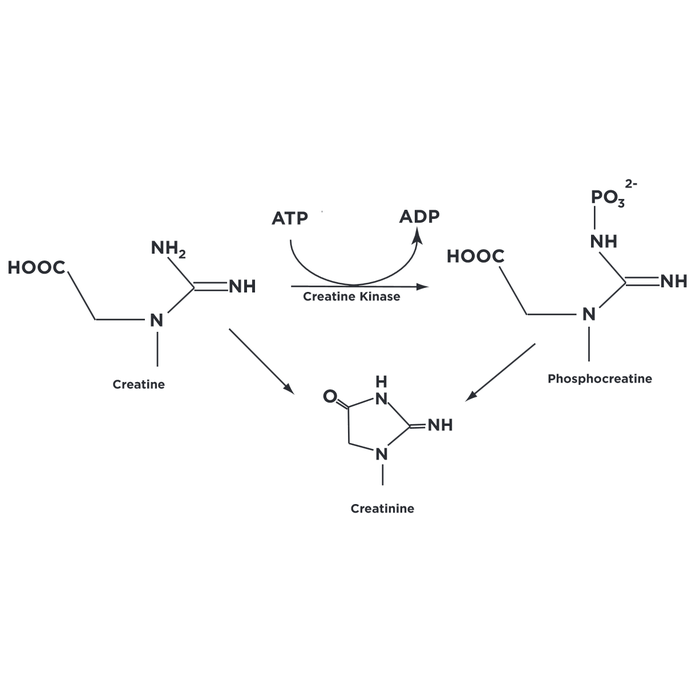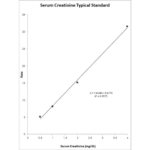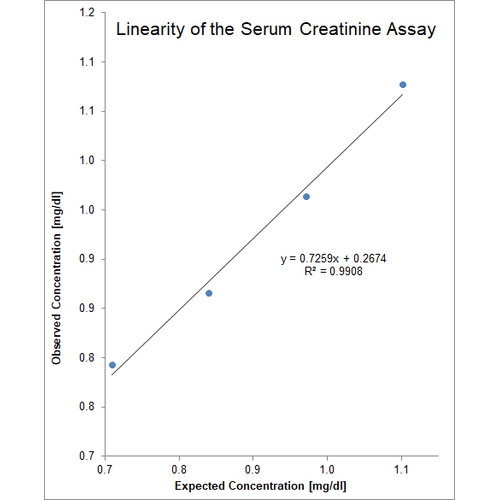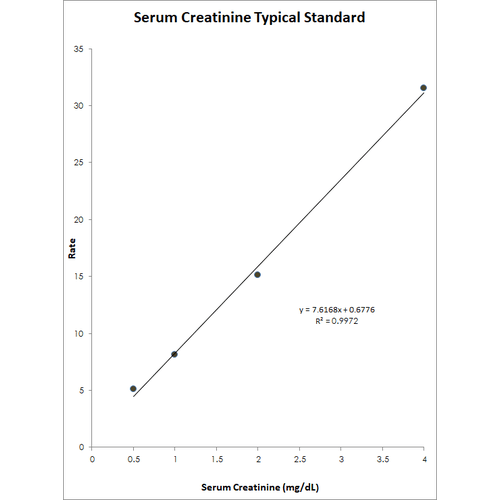| Product Name | Creatinine Serum Detection Kit |
| Description |
Colorimetric measurement of creatinine |
| Species Reactivity | Human, Mouse, Rabbit, Rat, Sheep |
| Platform | Microplate |
| Sample Types | Plasma, Serum |
| Detection Method | Colorimetric Assay |
| Assay Type | Direct Quantitative Assay |
| Utility | Colorimetric assay used to measure creatinine in samples. |
| Sensitivity | 0.085 mg/dL |
| Assay Range | 0.5 - 4 mg/dl |
| Precision | Intra Assay Precision: Four human serum samples were run in triplicate on a same-day assay determined that the mean and precision of the calculated concentrations were: Sample 1- 0.75 mg/dL, 5% CV Sample 2- 0.78 mg/dL, 6% CV Sample 3- 0.6 mg/dL, 4% CV Sample 4- 0.76 mg/dL, 6% CV Inter Assay Precision: Four human serum samples were run in triplicate on a same-day assay determined that the total range of 4-6% represents the variation between different assays. |
| Number of Samples | 91 samples in duplicate |
| Other Resources | Kit Booklet Lot No. KM486744 , Kit Booklet , Kit Booklet Lot No. SC188754 , MSDS , Creatinine Serum Kit Excel Analysis Worksheet |
| Field of Use | Not for use in humans. Not for use in diagnostics or therapeutics. For in vitro research use only. |
Properties
| Storage Temperature | 4ºC | |||||||||||||||
| Shipping Temperature | Blue Ice | |||||||||||||||
| Product Type | Detection Kits | |||||||||||||||
| Assay Overview | The Creatinine Serum Detection Kit is designed to quantitatively measure creatinine present in serum samples. A creatinine standard, calibrated to a creatinine standard, is provided to generate a standard curve for the assay and all samples should be read off the standard curve. Standards or samples are pipetted into a clear microtiter plate. An assay diluent is added to all standards, controls and samples. The color generating reaction is initiated with the StressXpress® Creatinine Reagent, which is pipetted into each well. The assay utilizes a kinetic absorbance method to overcome interference by colored compounds in serum. The absorbance of the colored product is read in a microtiter plate reader capable of measuring 490nm wavelength. For a total of 30 minutes, the optical density is read at 1 minute intervals. The concentration of creatinine is calculated using the Kinetic Mode software and samples are compared to the curve generated from the standards, or by using the Excel worksheet available for free download at our web site. The Jaffe reaction used in this kit has been modified to read creatinine levels in serum (8). | |||||||||||||||
| Kit Overview |
|
|||||||||||||||
| Cite This Product | Creatinine Serum Detection Kit (StressMarq Biosciences Inc., Victoria BC CANADA, Catalog # SKT-217) |
Biological Description
| Alternative Names | Methylguanidoacetic acid, N-Carbamimidoyl-N-methylglycine |
| Research Areas | Cardiovascular System, Cell Signaling |
| Scientific Background |
Creatinine is a metabolic byproduct of phosphocreatine, a high-energy phosphate reservoir used in ATP production. It is produced at a relatively constant rate and excreted by the kidneys without reabsorption, making it a reliable marker of renal function. In neuroscience, creatinine is widely used to normalize urinary biomarker levels—such as 8-OHdG or nitrotyrosine—ensuring accurate comparisons across individuals and time points. Its stability and low intra-individual variability (<15%) make it ideal for longitudinal studies. Altered creatinine levels may also reflect systemic conditions like diabetes or cardiovascular disease, which are known to impact brain health and increase the risk of neurodegeneration. |
| References |
1. Wallimann, T. et al., Biochem. J., 2000, 281, 21-40. 2. Wyss, M. and Kaddurah-Daouk, R., Physiol. Rev., 2000, 80, 1107-1213. 3. Raja Iyengar, M. et al., J. Biol. Chem, 1985, 260, 7562-7567. 4. Manjunath, G. et al., Postgrad. Med. 2001, 110, 55-62. 5. Gross, J.L. et al., Diabetes Care, 2005, 28, 164-176. 6. Anavekar, N.S. et al., New Engl. J. Med., 2004, 351, 1285-1295. |
Product Images

Creatine and p-creatine are converted non-enzymatically to the metabolite creatinine, which diffuses into the blood and is excreted by the kidneys. In vivo, this conversion appears to be irreversible and in vitro it is favored by higher temperatures and lower pH2. Creatinine forms spontaneously from p-creatine.

Creatine and p-creatine are converted non-enzymatically to the metabolite creatinine, which diffuses into the blood and is excreted by the kidneys. In vivo, this conversion appears to be irreversible and in vitro it is favored by higher temperatures and lower pH2. Creatinine forms spontaneously from p-creatine.




StressMarq Biosciences :
Based on validation through cited publications.